Shoulder Rehabilitation Exercises
What are Shoulder Rehabilitation exercises?
After an injury or surgery, an exercise conditioning program will aid you in return to daily activities and enjoy a more active, healthy lifestyle. Following a well-structured conditioning program will also aid your return to sports and other recreational activities.
This is a general rehabilitation program that gives a wide range of exercises. To ensure that the program is safe and effective for you, it should be done under your physiotherapist’s supervision. Talk to your physical therapist about which exercises will best assist you to meet your rehabilitation goals.
Shoulder rehabilitation exercises usually start in the early stages with mobility exercises, and progress to isometric or static shoulder exercises before dynamic, then functional or sports-specific exercises.
What are the Health Benefits you gain by doing shoulder rehabilitation exercises?
It is unknown exactly why exercise was beneficial and has been recommended that the effect of exercise may be multi-factorial. This may include:
- Effect on pain modulation. This relieves the pain in your shoulder joint.
- Giving a therapeutic effect on the structurally damaged rotator cuff muscles and tendons.
- Psychological benefits such as reducing fear of motion.
- Placebo.
- It improves muscular flexibility and mobility.
- It increases the strength of your shoulder muscles that are necessary for your daily life activities, like carrying a bag, lifting, throwing, etc.
- It also improves your shoulder joint infrastructure.
- It increases the Range of motion of your shoulder joint.
- It decreases tightness in the muscles by stretching them.
What are the Rehabilitation exercises for shoulder joints?
There are two phases of this exercise:
- Phase 1: Pain-relieving and Stretching exercises
- Phase 2: Strengthening exercises
Phase 1: Pain-relieving and Stretching exercises
Pendulum

Lean forward and put one hand on a counter or table for support. Let your opposite arm hang freely at your side.
Gently move your arm forward and back. Repeat the exercise by swinging your arm side-to-side, and repeat in a circular motion.
Do it the whole sequence with the other arm.
Do not round your back or lock the knees.
Perform 2 sets of 10 repetitions
Crossover Arm Stretch
Relax your shoulders and slowly pull one arm across your chest as far as possible, holding at the upper arm.
Pause the stretch for 30 seconds and then relax for 30 seconds.
Continue with the other arm.
Do not pull or put pressure on the elbow.
Perform 3 times on each side.
Passive Internal Rotation
Hold a stick behind the back with one hand, and lightly grab the other end of the stick with your other hand.
Pull the stick horizontally so that the shoulder is passively stretched to the point of feeling a pull without pain.
Pause for 30 seconds and then relax for 30 seconds.
Repeat on the opposite side.
Do not lean over or turn to the side while pulling the stick.
Perform 3 times on each side.
Passive External Rotation
Grab the stick with one hand and cup the other end of the stick with the opposite hand.
Keep the elbow of the shoulder you are stretching against the side of the body and push the stick horizontally, to the point of feeling a pull without pain.
Pause for 30 seconds and then relax for 30 seconds.
Do it on the other side.
During the motion, keep your hips facing forward and do not turn.
Perform 3 times on each side.
Sleeper Stretch
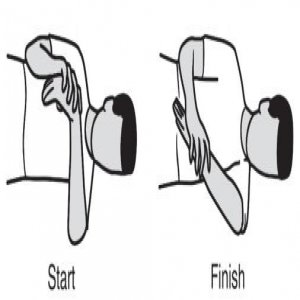
Lie on the right side on a firm, flat surface with the right shoulder under you and the arms bent. You can put your head on a pillow for comfort if needed.
Use your left arm to push your right arm down. Stop pressing down when you feel a stretch in the back of your right shoulder.
Hold this pose for 30 seconds, then relax your arm for 30 seconds.
Do not flex your wrist or press down on your wrist.
Do 4 repetitions 3 times a day.
Standing Row
Form a 3-foot-long loop with the elastic band and tie the ends together. Attach the loop to a doorknob or other stable object.
Stand holding the band with your elbow flexed and at your side, in the start position.
Keep your arm close to the side and slowly pull your elbow straight back.
Slowly back to the beginning position and repeat.
Squeeze your scapulae together as you pull.
Do 3 sets of 8 repetitions.
External Rotation With Arm Abducted 90°
Form a 3-foot-long loop with the elastic band and tie the ends together. Attach the loop to a doorknob or other static object.
Stand holding the band with your elbow flexed 90° and raised to shoulder height, in the begin position.
Keeping the shoulder and elbow level, slowly lift your hand until it is in line with your head.
Slowly back to the begin position and repeat.
Ensure your elbow stays in line with your shoulder.
Do 3 sets of 8 repetitions.
Internal Rotation
Form a 3-foot-long loop with the elastic band and tie the ends together. Attach the loop to a doorknob or other static object.
Stand holding the band with your elbow flexed and at your side, in the start position.
Keep the elbow close to your side and bring your arm across the body.
Slowly back to the begin position and repeat.
Keep your elbow pressed into the side.
Do 3 sets of 8 repetitions.
External Rotation
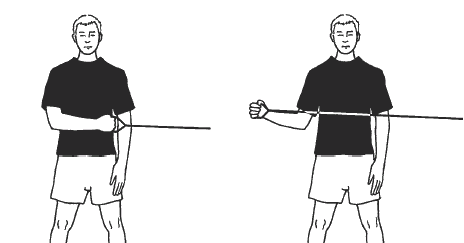
Form a 3-foot-long loop with the elastic band and tie the ends together.
Attach the loop to a doorknob or other static object.
Stand holding the band with your elbow flexed and at your side, in the start position.
Keeping your elbow close to the side, slowly rotate the arm outward.
Slowly back to the begin position and repeat.
Squeeze your scapulae together when you pull your elbow back.
Do 3 sets of 8 repetitions.
Elbow Flexion
Stand upright with your weight evenly distributed over both feet.
Keep your elbow close to the side and slowly bring the weight up toward your shoulder.
Pause for 2 seconds.
Slowly back to the starting position and repeat.
Do not perform the exercise too quickly or swing your arm.
Do 3 sets of 8 repetitions.
Elbow Extension
Stand straight with your weight equally distributed over both feet.
Lift your arm and bend your elbow with the weight behind the head.
Support your arm by placing your other hand on your upper arm.
Slowly straighten the elbow and bring the weight overhead.
Pause for 2 seconds.
Slowly lower your arm back down behind the head and repeat.
Keep the abdominal muscles tight and do not arch your back.
Do 3 sets of 8 repetitions.
Trapezius Strengthening
Put your knee on a bench or chair and lean forward so that the hand reaches the bench and helps support your weight. Your opposite hand is at your side, palm facing your body.
Slowly lift your arm, rotating your hand to the thumbs-up position and stopping when the hand is shoulder height, with your arms parallel to the ground.
Slowly lower your arm to the starting position to a count of 5.
Use a weight that makes the last few repetitions hard, but pain-free.
Do 3 sets of 20 repetitions.
Scapula Setting
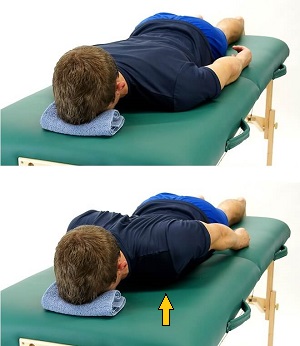
Lie on your stomach with your arms by the sides.
Put a pillow under your forehead for comfort, if needed.
Gently draw your scapulae together and down your back as far as possible.
Ease about halfway off from this pose and hold for 10 seconds.
Relax and repeat 10 times.
Do not tense up your neck.
Do 10 repetitions.
Scapular Retraction/Protraction
Lie on your stomach on a table or bed with the injured arm hanging over the side.
Keep your elbow straight and raise the weight slowly by squeezing your scapulae toward the opposite side as far as possible.
Return gently to the beginning position and repeat.
Do not shrug the shoulder toward your ear.
Perform 2 sets of 10 repetitions.
Bent-Over Horizontal Abduction
Lie on your stomach on a table or bed with the injured arm hanging over the side.
Keep your arm straight and slowly lift it to eye level.
Slowly lower it back to the original position and repeat.
Control the motion as you lower the weight.
Do 3 sets of 8 repetitions.
Internal and External Rotation
Take a supine position on a flat surface.
Extend the arm straight out from the shoulder and flex the elbow 90° so that your fingers are pointed up.
Keeping your elbow flexed and on the floor, slowly move your arm in an arc motion.
Move your elbow forward and backward to touch the floor.
Make sure to fix your arm on the floor.
Bring your elbow down to a 45° angle if you feel pain at 90°.
Use a weight that makes the last few repetitions hard, but pain-free.
Perform 3 to 4 sets of 20 repetitions.
External Rotation
Lie on the right side on a firm, flat surface with your right arm under you, cradling your head.
Hold the injured arm against your side, with your elbow flexed at a 90° angle.
Keep your elbow against the side and slowly rotate the arm at the shoulder, lifting the weight to a vertical position.
Slowly lower the weight to the original position to a count of 5.
Do not let your body roll back as you lift the weight.
Do 2 sets of 10 repetitions.
Internal Rotation
Lie on a firm, flat surface on the side of your right arm.
Put a pillow or folded cloth under your head to keep the spine straight.
Hold the injured arm against your side, with your elbow flexed at a 90° angle.
Keep your elbow flexed and against your body and slowly rotate the arm at the shoulder, lifting the weight to a vertical position.
Slowly lower the weight to the original position.
Do not let your body roll back as you lift the weight.
Perform 2 sets of 10 repetitions.
Phase 2: Strengthening exercises
It has 4 stages :
Stage 1 Strengthening
Wall push-ups

Stand around 20cm from the wall.
Put your hands against the wall palms flat and fingers up.
Lean towards the wall by flexing your elbows.
Slowly change the pressure from one shoulder to the other by rocking from side to side.
Pause for 30 seconds, repeat 3 times
Once doing this easily, move your feet further away from the wall.
Seated Stabilization
Sit on a bench or firm chair with the hands on the chair.
Transfer your weight from one side to the other, putting gradually increasing weight through each arm to support you on either side as you slowly move side to side.
2 sets of 15 repetitions.
Isometric Internal rotation
Standing with your inner forearm against the wall and your elbow at the side.
Push the hand against the wall trying to rotate your forearm into the body.
Continue pushing for 10 seconds then relax. 2 sets of 15 repetitions.
Isometric External Rotation
In this case, stand beside a wall with the outside of your flex forearm against the wall.
Push outwards against the wall.
Continue pushing for 10 seconds and then relax. Do it in 3 sets of 10 repetitions.
Side-lying ER
Lying on the unaffected side, rotate your arm outwards as far as comfortable, and slowly back it to the starting position.
Repeat as tolerated, slowly gaining up to 3 sets of 10 repetitions.
This can be repeated with the arm held in front of you, with your elbow at the same level as the shoulder, supported on pillows or books.
Rotate your arm outwards towards the roof. The goal for 3 sets of 10 repetitions
Shoulder blade circles

Shrug your scapulae forward, up, back, and then down in a circle.
Perform with both forward and backward circles. Do it for 1-2 minutes, 3 times daily.
Shoulder Blade Retraction
Stand in the pendulum position, flexing forwards from the waist with both arms hanging forward.
Draw your scapulae back to squeeze them together behind your back.
Pause for 5 seconds and then slowly release.
Do it 10 times, 3 times daily.
Stage 2 strengthening
Forward flexion
Elevate your arm forwards as far as comfort permits, hold for 5 seconds, then slowly back to the starting position.
Repeat as tolerated, slowly gaining up to 3 sets of 10 repetitions.
Scratching the Itch: part 1
Reach up behind the back as far as you can go comfortably.
From the push it a little further – you’ll feel it pulling in the shoulder, which may be a bit uncomfortable.
Pause for a few seconds and then back off until it is comfortable. Do it this 10 times. Perform 3 sets.
Scratching the Itch: part 2
Reach over your other shoulder and try to reach across your scapula.
Begin at the edge of what is comfortable and then push a bit further, hold for a few seconds, and then back off.
Do it this 10 times. Perform 3 sets.
Drawing the Sword
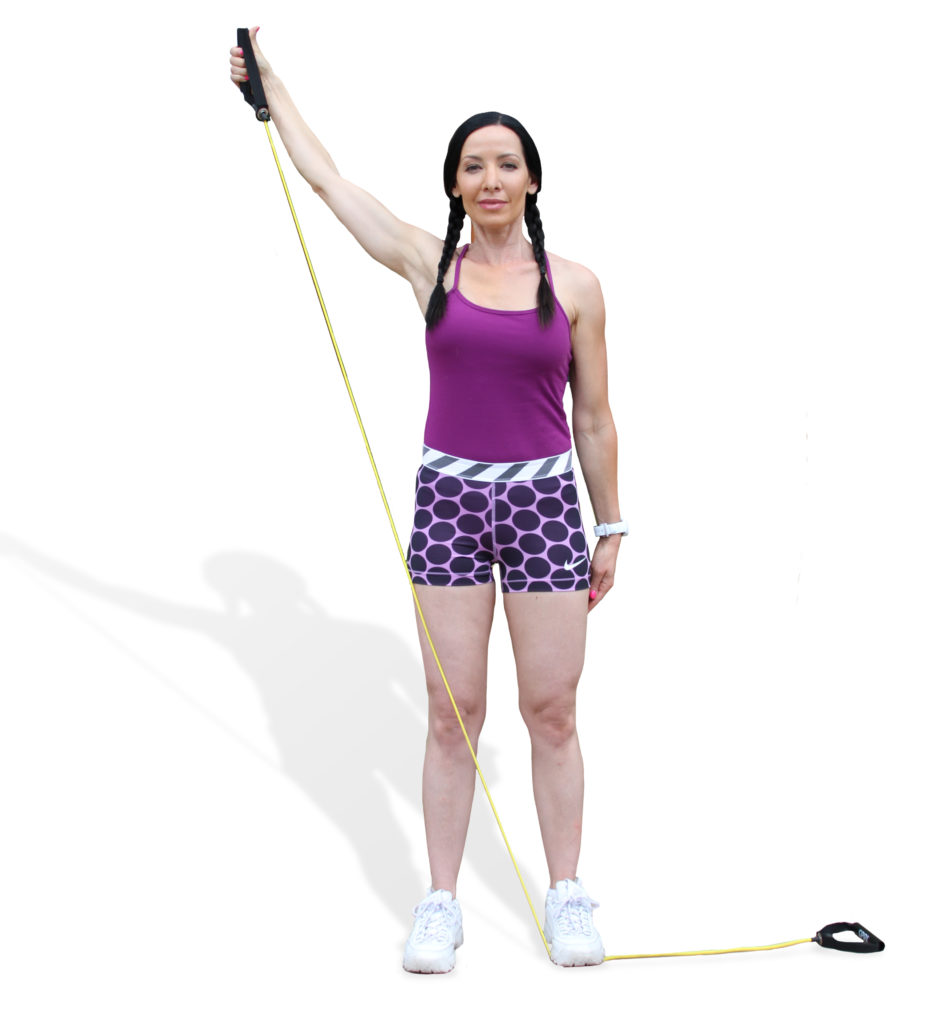
This motion mimics the action it is named for.
Imagine you have a sword in its scabbard by your other hip.
Reach down and grab it with your hand, then raise your arm, out to the side and back so that the hand moves diagonally from beside one hip to above the opposite shoulder.
2 sets of 15 repetitions.
Stage 3 strengthening
2 point kneeling
Kneel on all fours. Raise your good shoulder and opposite knee so that your weight is going through the sore shoulder.
Pause for 30 seconds. Repeat 3 times. Gradually increase the duration of the position as you get stronger.
Cobra pose
This exercise gives good posture and strengthens the back muscles to put the shoulder in a better position for pain-free function.
Lying face down, turn the hands so the palms face down (or outwards if you are flexible) and thumbs are facing out away from the body.
Open out and extend using your back muscles to raise your chest from the floor.
Pause for 30 seconds. 3 repetitions. Gradually increase the duration of the position as you get stronger.
Swiss ball Stability
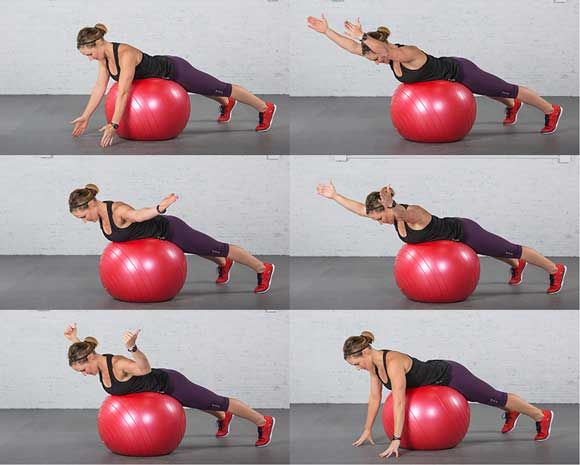
Kneeling, put both hands on the sides of a Swiss ball and lean forwards.
Hold this position for 30 seconds. 3 repetitions.
To increase the intensity, improve the duration of the pose and move your knees further away from the ball.
Once comfortably doing two-handed, do the same exercise onehanded.
Theraband strengthening
Using a progressive resistance elastic (Theraband) to give resistance for four movements.
In each motion aim for 3 sets of 10 repetitions.
Increase the resistance of the band if finishing the exercises easily.
As for the stretching exercises. Take the motion to the end of your comfort zone, then push a little further and pause for several seconds before backing off.
External rotation: Have the band attached at waist height (a door handle is good) on the side opposite the exercising shoulder. Keeping the elbow to the side, rotate your hand outwards as far as you can comfortably go. Slowly back to the start position.
Internal rotation: Keep the band in the same place, but turn around, so the band is under tension with the arm rotated outwards in the ending position of external rotation. Rotate the arm in to touch the belly. Slowly back to the starting position.
Forward flexion: Have the theraband attached around your foot. Begin with your arm straight, about waist height. Lift your arm against the resistance of the band. Lift your arm as far as is comfortable plus a bit more, hold for several seconds, then slowly lower.
Abduction: Again, the theraband is attached at foot level. Have the arm about 30° forwards of being straight out to the side. Lift your arm against the resistance of the band. Lift your arm as far as is comfortable plus a bit more, hold for several seconds, then slowly lower. Once doing this comfortably, you can take the arm fully out to the side and repeat the exercise.
Stage 4 strengthening
Theraband Drawing the Sword
Fix the theraband under your foot or at ground level.
Perform the Drawing the Swords exercise with the theraband.
2 sets of 15 repetitions.
External rotation at shoulder height
Have the band attached at shoulder height on the side opposite the exercising shoulder.
Begin with the elbow at shoulder height.
Without moving the elbow, rotate the hand outwards (back and upwards) as far as you can comfortably go.
Slowly back to the start position.
4 sets of 8 repetitions.
Internal rotation at shoulder height

Keep the band in the same place, but turn around, so the band is under tension with the arm rotated outwards in the finishing position of external rotation.
Now, without moving the elbow, rotate your hand downwards until it is facing directly forwards.
Slowly reverse to the starting position.
4 sets of 8 repetitions.
Once doing this easily, progress the motion by raising the elbow above shoulder height.
Seated push-ups
Sit on a firm chair and lift your body off the chair using your arms.
Pause for 5 seconds and lower. Do 3 sets of 3 repetitions.
Progress the exercise by increasing the duration of the pause.
Cable rows

Fix the theraband at ground level. Keeping the elbow close to your body move your arm backward.
4 sets of 8 repetitions.
This exercise can be varied by rotating the arm outwards, so your forearm and palm are facing forwards.
Repeat the same movement of extending the arm back, while maintaining the elbow close to the body.
Ball throwing
This is mimicking the movement of throwing a ball overhand in slow motion.
Begin gently and gradually increase the range of motion and speed of the action as you feel comfortable.
4 sets of 8 repetitions.
Once you are comfortable with this exercise, it can be progressed by utilizing a theraband to provide resistance to the motion—again goal for 3 sets of 10 repetitions.
There are other Strengthening exercises you can do after the last stage of your Rehabilitation
These are below :
- Wobble board exercises for shoulder stability
- Horizontal Abduction In Prone
- Neck Stretches
- Lateral Raises
- Barrel Hug
- Standing Upright Rows
- External Torso Rotation
- Internal Torso Rotation
- Shoulder I-Y-T’s
- Shoulder Y and Ts
- Shoulder U’s
- Rhomboid Rows
- Shoulder Wall walk
- Shoulder Isometrics exercise
- Shoulder Pectoralis Stretch
- Shoulder Plyometrics
- Shoulder Wall Handstand
- Soccer Ball Shoulder Exercises
- Shoulder Rhythmic Stabilization
- Push-up Rows
Wobble board exercises for shoulder stability
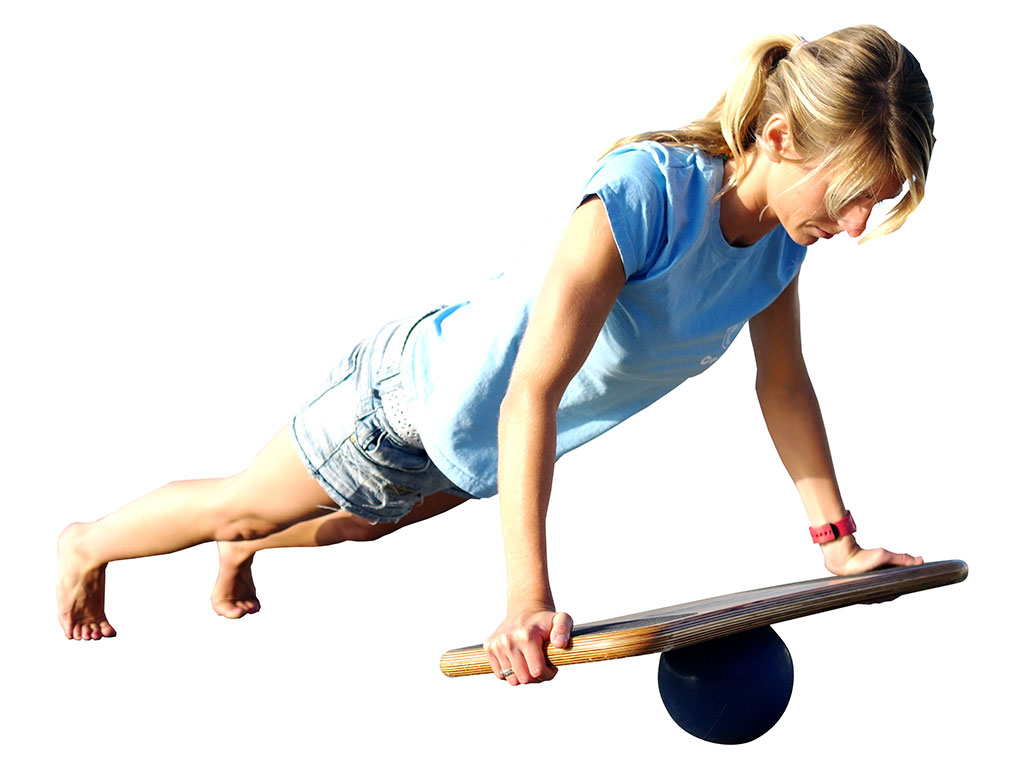
The athlete begins with their hands on the wobble board shoulder-width apart.
For the more standard version of this exercise, the athlete supports themselves on their knees, this can be progressed through to the toes.
Whilst maintaining balance the athlete performs circular motions on the board.
Horizontal Abduction In Prone
The athlete lies with their arm over the border of the table.
The arm with the weight is raised into a horizontal extension.
Neck Stretches
Stand with the feet positioned hip-width apart.
Permit your arms to hang loose at your sides.
Look straight ahead.
Tip your head to the left and try to touch your ear to your shoulder.
You will feel the stretch that pulls along your right shoulder and neck.
Pause for 10 seconds.
Do three reps for each side.
Lateral Raises
Grasp a dumbbell in each hand while standing.
Keep your back perfectly erect and brace your abdominal muscles.
With controlled motion, slowly lift the dumbbells out to the side so that your arms are parallel to the ground.
Your elbow should be slightly flexed.
Back to the starting position.
Do it 10 to 12 times.
Barrel Hug
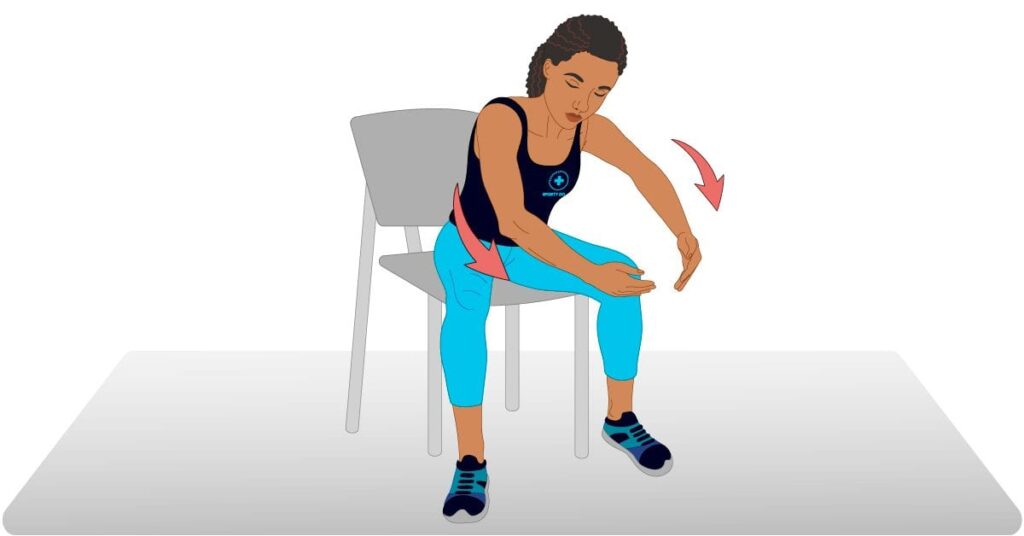
Sit in a chair.
Keep your back erect.
Lift your arms to shoulder height.
Fold your elbows so your fingers meet (as if you are hugging a barrel).
Rotate the body from side to side
Do the rotation with a slight bend at each side to improve the range of motion and work the side muscles.
Standing Upright Rows
Stand upright.
Grab a barbell or weight using an overhand grip.
Keep the feet hip-width apart.
Pull your shoulders back while arching the lower back.
Raise the barbell so it is just under your chin.
Make sure your elbows are higher than the hands. If not, pull your elbow up.
Lower the bar back and repeat.
Do 10 reps.
External Torso Rotation
Sit in a chair.
Tighten the abdominal muscles.
Exhale while rotating the torso to one side.
Keep the hips facing forward.
Rotate your upper body, shoulders, and head as one.
Pause and then back to your original forward-facing position.
Alternate twisting sides.
Internal Torso Rotation
Holding onto the affixed TRX with both hands you will lean the body back with your legs spread slightly.
Use your body’s inner torso to roll to the side and then back to your starting position. Your hands will be off to the side.
Alter the intensity by taking a single step forward or back.
Do 10 reps on each side.
Shoulder I-Y-T’s
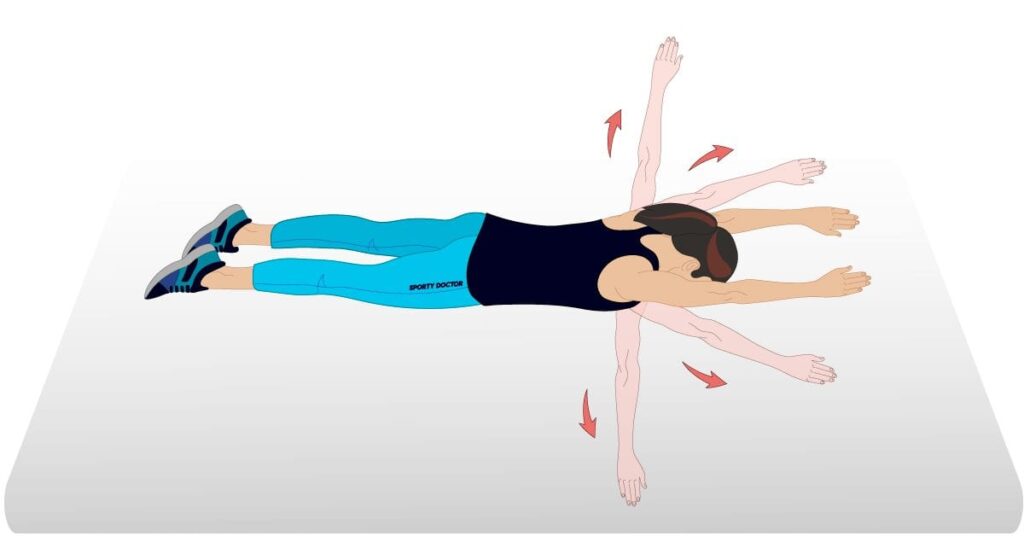
Lie in a prone position.
Extend the arms and legs. Your palms should be flat on the mat and the toes pointed.
Stiffen the abdominal muscles.
Pull the shoulders back and down. You will attempt to hold this position during the exercise.
Exhale and raise your arms off the floor. You must keep the letter ‘I’ formation for 5 to 10 seconds. Do two to four reps.
Exhale and raise your arms off the floor to form a ‘Y’ position. The palms will be inward.
Use your shoulders to implement the Y raise of your arms. Pause the pose for 5 to 10 seconds.
Do two to four reps.
Exhale and move the arms into a ‘T’ position. Again, use your shoulders to raise your arms. Pause for 5 to 10 seconds. Do two to four reps.
Shoulder Y and Ts
You will stand in a straight position and use dumbbells. Only use light dumbbells.
Lean forward slightly.
Bring the arms outward straightening your elbows and grasping the dumbbells.
Slowly lower the arms.
Repeat five times.
Position the arms so that your palms are facing outward and the thumbs are pointing towards the roof.
Raise your elbows to shoulder level.
Slowly lower.
Do it five times.
Shoulder U’s
The Reverse Shoulder Stretch is like forming a U formation. The exercise is relatively easy and needs no equipment. This will aid stretch your posterior deltoid, the muscle on the backs of your shoulders.
Stand upright.
Interlock your fingers behind the back at the top of your butt to form a U.
Maintain a straight back with your scapulae muscles together.
Keep the arm bone straight on each arm.
Push the arms up away from your buttocks and low.
Pause for 30 seconds.
Do a rep of five.
Rhomboid Rows
Grab a pair of dumbbells in each one of your hands.
Stand so you are facing toward the seat of the incline bench.
Straddle the seat and lean your torso forward against the bench.
Flex your knees so that your feet will slide backward.
Bend both ankles and dig your toes into the floor to offer support. The arms should be hanging down.
Exhale and flex your elbows so that you are lifting the weights upward toward the rib cage.
When you reach the top of the lift motion squeeze your shoulder blades together.
Pause for three seconds and then lower the weights.
Do 10 to 12 reps.
Shoulder Wall walk
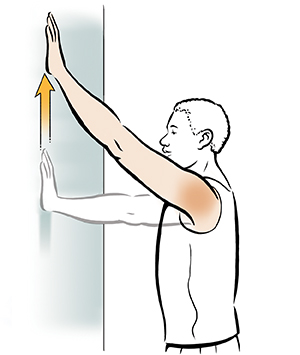
Select an open wall or door jam.
Facing the wall slowly walk the fingers up the wall.
You walk up as far as you can while keeping the space between your shoulder and your ear.
This may decrease how much range of motion you gain initially but it will your mechanics correct and lower the chance of developing compensations.
Once you have reached the maximal height, hold for 3-5 seconds and then slowly walk the fingers back down.
Do this for 10 repetitions.
Shoulder Isometrics
Standing near a doorway or wall with your elbow flexed.
External Rotation (ER): Stand with the back of the wrist against the wall. Keep your wrist neutral as you give a force externally as if your palm was going away from you. Begin with 20% force and slowly work up to 80%. Pause for 5-10 seconds for 10 repetitions.
Internal Rotation (IR): Stand on the opposite side of the wall with your palm facing the wall. Give a sub-maximal force without eliciting pain. Begin with 20% force and slowly work up to 80%. Pause for 5-10 seconds for 10 repetitions.
Abduction: Stand with the elbow against the wall. Give force through the elbow. Begin with 20% force and slowly work up to 80%. Pause for 5-10 seconds for 10 repetitions.
Adduction: Step away from the wall and put a towel between your arm and your thorax (rib cage). Give a force as if you are squeezing your side. Begin with 20% force and slowly work up to 80%. Pause for 5-10 seconds for 10 repetitions.
Flexion: Face the wall and give force into the wall through your wrist keeping your wrist neutral. Begin with 20% force and slowly work up to 80%. Pause for 5-10 seconds for 10 repetitions.
Extension: Face away from the wall and give force through the elbow. Begin with 20% force and slowly work up to 80%. Pause for 5-10 seconds for 10 repetitions.
Shoulder Pectoralis Stretch
This is an important stretch that aids improve your posture, and your shoulder mechanics, and even aids with neck pain.
Stand next to a doorway. Raise your arm to 90 degrees so your palm is on the frame.
You can put your arm lower if there is shoulder pain.
You should experience a gentle pull on the chest wall.
Now twist your body to the outside to increase the stretch.
This should be pain-free. Pause for 30 seconds.
Shoulder Plyometrics
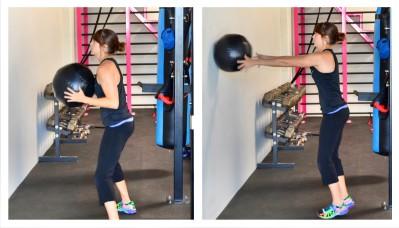
This advanced exercise is perfect for any throwing athlete.
Facing the wall, in a throwing position with the feet separated. Always engage your core.
You want to throw the ball into the wall to get a rhythm going.
You can begin with a slow rhythm and gradually increase your pace.
Practice for 30 seconds and slowly improve to 60 seconds.
Begin with two hands and switch to a single hand as tolerated.
Shoulder Wall Handstand
Position yourself near a wall.
Put your feet on the wall and slowly walk your feet to get the body to be closer to the wall.
The demands on the shoulder increase as you get closer.
Once at the wall, do shoulder shrugs. Back to standing slowly.
Soccer Ball Shoulder Exercises
This is exercise is a progression of the wall push-up and needs more scapular stability.
Position the ball on the wall at chest level and make a diamond shape with the hands.
Push up: Keeping your shoulders in a protracted position (scapulae away from your spine) do a push-up on the ball. The ball will attach and increase work as you try to stabilize.
Circles: Keeping your hands on the ball, do small circles along the wall. You will have to transfer your center of gravity. Work Clockwise and counterclockwise. A progression of this exercise is to do this with only one arm. Ensure to keep the elbow straight.
Shoulder Rhythmic Stabilization
A challenging exercise that concentrates on shoulder and scapular stabilization.
You can do this exercise on a ball or the floor with your knees bent.
You will begin with a light weight in your extended arm. Do small circles in one direction for 30 seconds, then circles in the opposite direction for 30 seconds.
Next, protract your arm (reaching up so your scapulae are off the floor/ball) and do little circles in 30 second-bouts clockwise and counterclockwise.
You want to make sure the movement is slow and controlled.
Push-up Rows
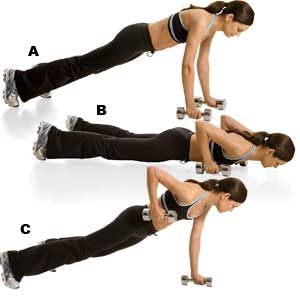
Begin in the push-up position with hands holding the dumbbell weights.
Do a regular push-up, weight shift to one side, and perform a row.
Make sure you change sides and keep your hips level.
To make this harder, do a push-up windmill.
You will do a push-up and as you row turn your hips so you are in a side plank position. Make sure you change sides.
Do 2-3 sets of 10-15 repetitions.


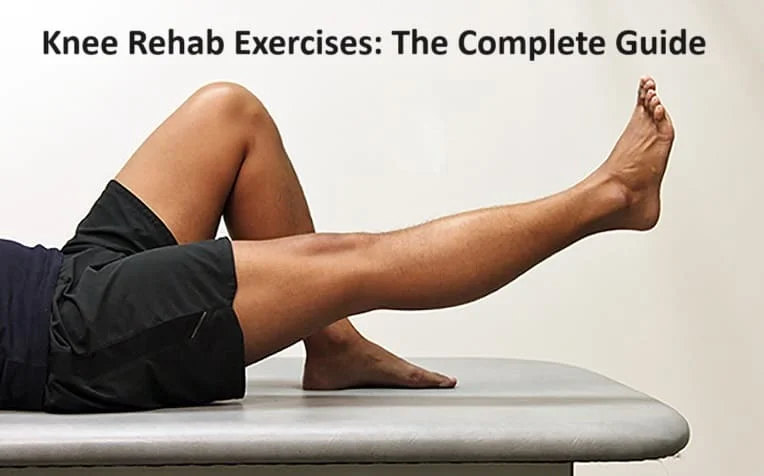
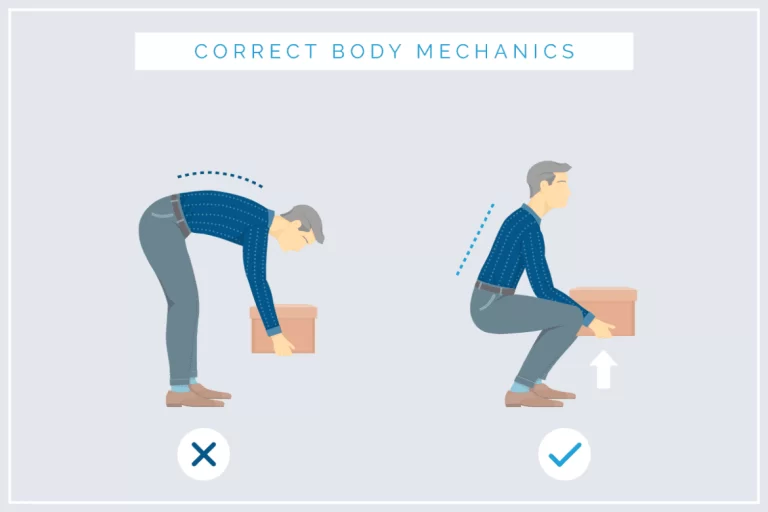
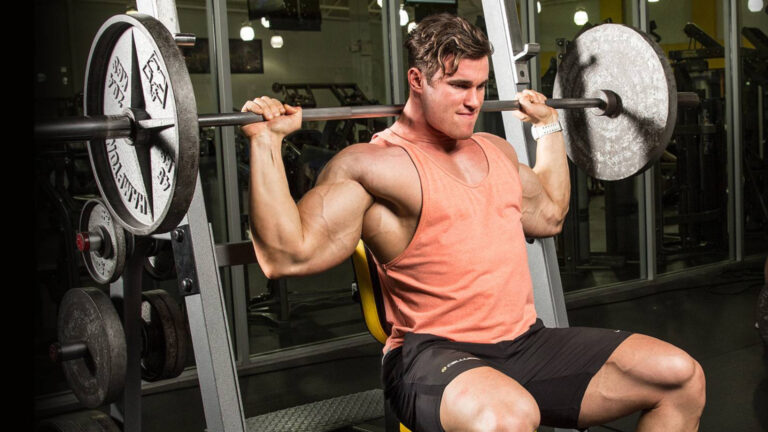
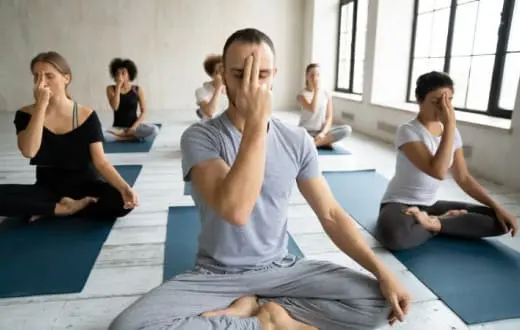

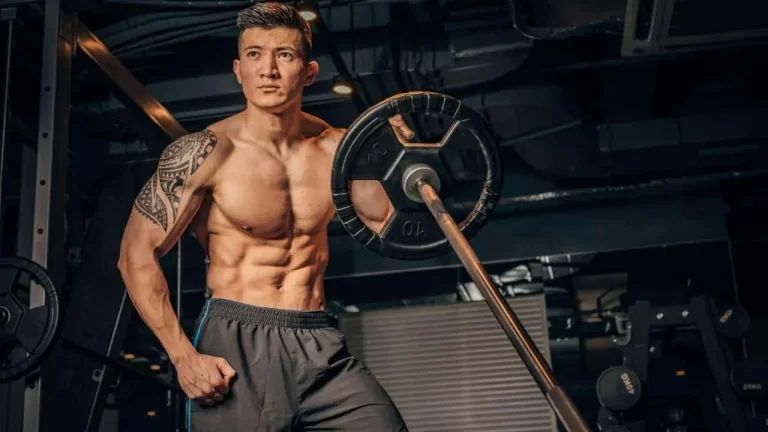
2 Comments